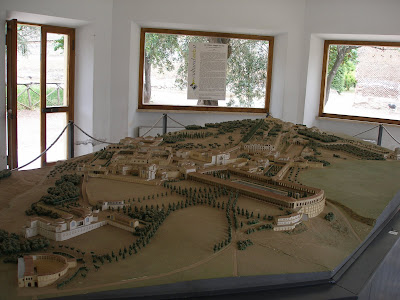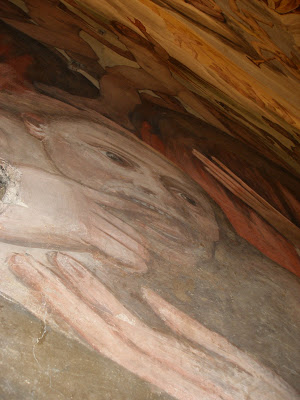The Enoteca Corsi is little restaurant back behind the Pantheon that I'd been to once before, and had been wanting to go back to ever since. It's only open for three hours at lunch time, and has a small menu (four or five main dishes) that changes frequently. They also have several larger, "family-style" dining tables, so if you go alone, you might end up eating with strangers. This was the case when I went on Saturday. Sort of.
I was sitting next to an American couple who I thought looked a little familiar. Sure enough, after a few minutes the girl leaned over and said, "I think we were sitting next to you at dinner the other night."
That's right! They were at the table next to me at il Gabriello two nights ago. Small world! Turns out they were on their honeymoon and had already been to Venice, Tuscany, and the Cinque Terre. So we got to chatting about lovely Italian destinations, travel in general, how much we like the Enoteca Corsi, etc. They were so nice!
Veal and potatoes. There's no messing around with fancy presentation here; mama puts the food on a plate in the kitchen, some angels weep over it for a minute or two, and then I get to eat it. OK, I don't have proof of the weeping angels, but I have seen the mama and she was dressed all in white. She was also sporting a white paper chef's hat and looked like she could probably double as the security detail if needed. Behave yourselves, everyone.
Well, we were a little confused by the whole situation, especially since we had already paid for lunch. Did she leave these here by mistake? Were her hands full and she needed a place to set them down for a minute? But then the waitress reappeared with three liqueur glasses and nicely told us to be cool and drink our treats.
So we said grazie about a dozen times, and then we had a really good time.

Chocolate liqueur in a re-purposed water bottle. I don't care why it's in there. I just know that we have 2.5 inches of muddy delirium left before it's gone.

The Groom expounds on the merits of each beverage and why they are soooo (surprisingly) good together.
"Honey, you have to try this. Hey Monica, will you take a picture of this for our wedding album?"
"My pleasure, guys." (I hope you're married for 100 years).
After lunch I had to make a little detour for a coffee break before I could consider doing anything productive with the rest of the day.
An hour later, walking down a side street: a little reminder of my lunchtime friends.
Next, I decided to embark on a little walking tour of the Trastevere neighborhood. This is a traditionally working-class area (although it is apparently becoming more popular and pricier) across the river from the city center. The name Trastevere literally means "across the Tiber". The atmosphere here is a little more salt-of-the-earth than downtown Rome, with a lot of cool medieval buildings (or remnants of them) mixed in to give the neighborhood some context.

See that little brown stone tower with the cross on top of it? That's the oldest working church bell tower in Rome. It was built in 1069. Way to hang in there, little tower!

One thousand years ago: a synagogue. Now: a restaurant. If these walls could talk...
Rome has the oldest Jewish community outside of Palestine, and many of them lived in Trastevere until they were ghetto'd by Pope Paul IV in the 16th century.
The next stop on my Trastevere walk was the Church of St. Cecilia. Apparently, also a popular site for weddings because...
I came across newlywed couple #3 in the courtyard of the church.
OK, how much Limoncello did I have at lunch, anyway?! Is this some kind of marital-themed pink elephant dream? If all of these newlyweds suddenly become technicolored and start dancing a jig in my personal space, I'm going to be concerned. Although that could be kind of fun...

Church of St. Cecilia: exterior and courtyard.
Whew. That couple doesn't look like they're going to start dancing in the near future.
Cecilia was a Roman woman who converted to Christianity during a time of persecution. She waited until her wedding night to reveal her conversion to her new (pagan) husband, and also informed him that she wanted to remain chaste. Oh my. Fortunately, an angel intervened on Cecilia's behalf. Her husband converted to Christianity and decided to make a career of burying martyred Christians in the catacombs. They were both eventually executed.
Ah, yes. Now I see why this church is such a popular place to get married.

Interior of the Church of St. Cecilia. The canopy over the altar is from the 13th century, the chairs are from couple #3's wedding.

Statue of Cecilia encased below the church altar.
No, this is not a depiction of Cecilia being coy on her wedding night. Apparently, her remains became the target of a relic hunt during the Counter-Reformation. The story goes that when her tomb was opened, her body was still perfectly intact, but turned to dust a moment later. Among the witnesses to this event was a sculptor named Stefano Maderno. He made this statue based on his memory of how Cecelia looked before fulfilling the old "dust to dust" adage.
Next stop (after wandering around some side streets to see what's what): The Church of Santa Maria in Trastevere.

This is one of the oldest churches in Rome (4th century), and the piazza is a major meeting place for the neighborhood. The exterior of the church is interesting enough, but what I really love is the little scene going on in the plaza.

The interior of St. M. in T. A lot of interesting and beautiful things to look at in here. Example: the granite pillars and the marble for the floor mosaic were pilfered from ancient Roman ruins.
More wandering through the neighborhood on my way home:


Just in case I hadn't yet picked up on the theme of the day, these two were standing outside of the Castel Sant' Angelo with a bottle of champagne as I walked back to the hotel. I knew the picture quality would be poor because it was so dark out, but I took one anyway because I had to add them to my collection. I guess this makes Bride and Groom #5 if you count Cecilia and The Crypt Keeper. Cheers.









































